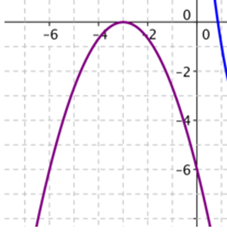Or search by topic
Number and algebra
Geometry and measure
Probability and statistics
Working mathematically
Advanced mathematics
For younger learners
Name That Graph



- Problem
- Student Solutions
Sameer from Hymers College in the UK described a method for finding the equation of the curves:
Just from looking at the graph I know it is a quadratic graph, this means it contains an $x^2.$ The two forms of this [equation] are expanded and factorised.
An expanded formula looks like this: $y = x^2 -3x -4$
However solving a quadratic graph requires the factorised formula.
In order to factorise an equation, you need to look for two numbers.
In the equation $x^2 -3x - 4 = 0,$ the two numbers must add together to form $-3$ and multiply together to form $-4.$ These numbers are $1$ and $-4.$
The equation will look like this: $(x+1)(x-4) = 0.$
It has two solutions, this is because one of the brackets must equal $0.$
$x + 1 = 0$ or $x - 4 =0$ $\Rightarrow$ $x = -1$ or $x = 4$
Therefore $y=0$ when $x = -1$ or $x = 4,$ so the graph passes through $-1$ and $4$ on the x axis. These are the roots.
Sameer and Sam from England used this idea to find the equation of the first graph. Sam wrote:
The curve crosses the x axis at $3$ and $-1.$ So $x= -1,3.$ $(x+1)(x-3)$ because at least one of the brackets has to equal $0.$ When you multiply out the brackets you get the equation [$y=$]$x^2-2x-3.$
Sergio from Kings College Alicante in Spain used another method to check this answer:
This is Sergio's work for the second graph:
Anna got a different equation for the second graph. Anna's method is similar to the method Sergio used to check the equation of the first graph. Here is Anna's work:
The minimum point of the graph is when $x=2,$ therefore $y=a(x-2)^2+k.$
$y=-4$ when $x=2$ therefore $k=-4.$
When $x=0,$ $y=8$ because the y-intercept is $8.$ Therefore $8=a\times(-2)^2-4 = 4a-4$ and so $a=3.$
So the equation is $y=3(x-2)^2-4.$
Check when $y=0:$
$\begin{align}3(x-2)^2-4&=0 \\ 3(x-2)^2 &= 4\\ (x-2)^2 &= \dfrac43 \\ x-2&=\pm\dfrac{2}{\sqrt3} \\ x&=2\pm\dfrac{2}{\sqrt3}\end{align}$
$2+\dfrac{2}{\sqrt3}\approx3.15$ and $2-\dfrac{2}{\sqrt3}\approx0.85$ which looks about right.
Can you see why Anna and Sergio got different answers? Whose answer do you think is right?
This is Sameer's work for the third graph:

In this graph, the line is upside down compared to the others; this is because the $x^2$ is negative. The root is $-3,$ so the only solution is $-3.$
$x = -3$ or $x = -3$
$x + 3 = 0 or x + 3 = 0$
$(x+3)(x+3) = 0$
However, the $x^2$ is negative so one $x$ needs to be negative. This has to be the $x$ in the bracket with a $3$ so that the $3$ also becomes negative.
$-(x+3)(x+3) = 0.$
The expanded form is $-x^2 -6x -9$
Sergio added:
We need a y-intercept at $-6,$ not at $-9,$ so we multiply everything by $\dfrac{-6}{-9}=\dfrac23$:
$y=-\frac23x^2 -4x -6$
You may also like
Powerful Quadratics
This comes in two parts, with the first being less fiendish than the second. It’s great for practising both quadratics and laws of indices, and you can get a lot from making sure that you find all the solutions. For a real challenge (requiring a bit more knowledge), you could consider finding the complex solutions.
Discriminating
You're invited to decide whether statements about the number of solutions of a quadratic equation are always, sometimes or never true.
Factorisable Quadratics
This will encourage you to think about whether all quadratics can be factorised and to develop a better understanding of the effect that changing the coefficients has on the factorised form.


